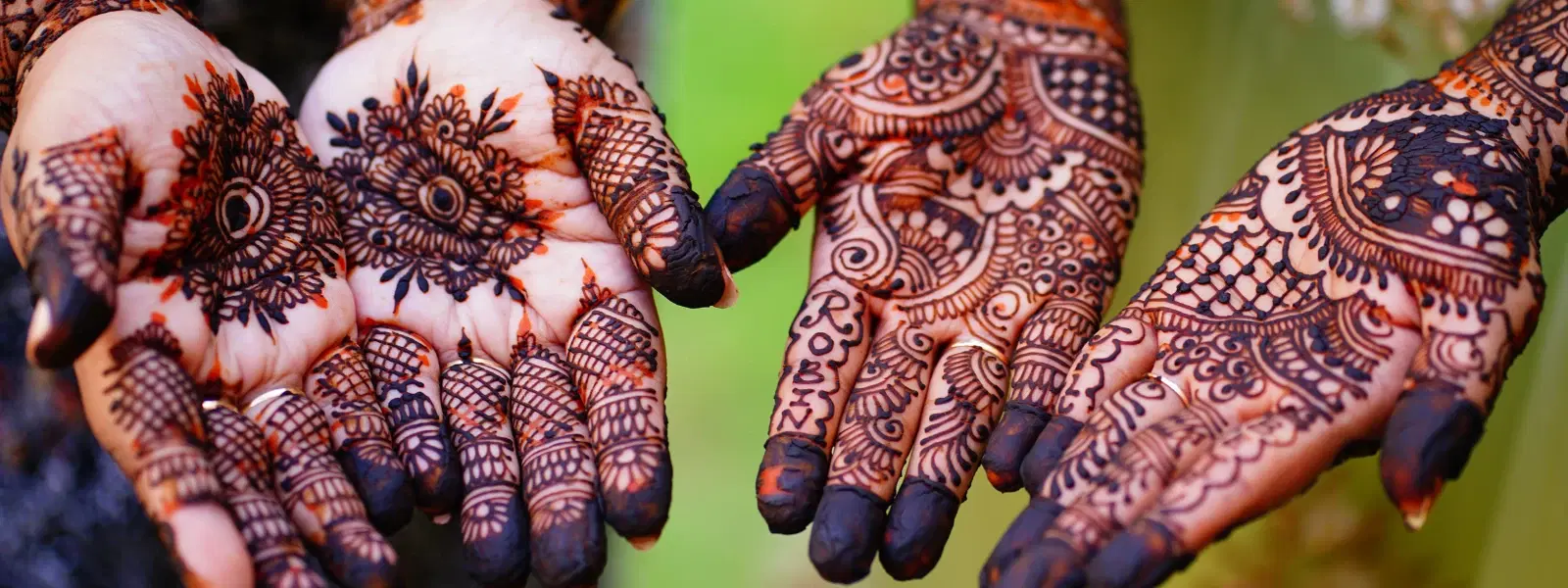
Apparel & Accessories
•03 min read
-b4b0ee01-7102-4782-b4cc-72450eaeb58c.png&w=3840&q=75)
Mehndi designs enhance traditions with an art form that speaks volumes about individuality and culture. In this post, we explore the nuances between Bridal Mehndi Designs and Arabic Mehndi Styles. You will learn the unique elements of each style and understand which design fits your personality and the occasion at hand.
Mehndi designs, often recognized as henna patterns, hold deep cultural significance. These designs are not just for adornment but narrate stories of love, prosperity, and heritage. Traditional mehndi art has evolved into a diverse expression that embraces everything from simple henna designs to intricate mehndi patterns. This art interacts with our idea of self-expression and identity by adapting to various cultural celebrations and personal occasions. The designs come in multiple forms, including floral mehndi motifs that merge with modern festive henna designs, offering a versatile range that suits hand and foot mehndi as well as accent pieces on smaller areas.
Several factors contribute to the allure of mehndi designs. They carry an aura of celebration that is both intimate and communal. The personalization is limitless—each pattern can be a tribute to personal stories, making them truly one of a kind. Such designs are created with passion, merging artistry with tradition.
Bridal mehndi designs are crafted with attention to detail and imbued with symbolism. These designs are known for their complex motifs and are often a focal point during weddings. Intricate mehndi patterns cover not only the hands but also extend to full hand and foot mehndi designs, which include traditional symbols like peacocks and paisleys. The customization options are endless, allowing a bride to incorporate elements such as significant dates or personalized motifs. This art form, deeply rooted in tradition, signifies the beauty of commitment and the beginning of a new chapter in life.
The application of bridal designs is a time-intensive process. The elaborate detailing often demands hours of artistry to achieve flawless execution. Complementing these designs with mehndi accessories like bangles, rings, and anklets further enhances the bridal look by uniting the art with traditional jewelry.
-961388ae-2e6f-4656-ab76-3780ab6a42c4.png&w=3840&q=75)
Arabic mehndi styles have redefined simplicity in the realm of henna art. These designs emphasize bold lines combined with open spaces, creating a minimalist yet impactful appearance. The hallmark of these styles is the use of floral mehndi motifs and elegant curves that naturally enhance the beauty of the wearer. Their clean aesthetics make them ideal for events that call for understated sophistication. Many opt for these simple henna designs owing to their quick application process, allowing for flexibility in busy celebration schedules.
For those who adore contemporary elegance, Arabic mehndi styles offer a refreshing alternative. This minimalistic approach enhances accessories since the negative spaces in the designs allow jewelry such as bracelets and rings to shine without being overwhelmed by complex patterns.
Expert Tip: Minimalist Beauty
Arabic mehndi styles not only celebrate modernity but also provide a perfect canvas for showcasing carefully chosen accessories. By opting for these simple yet stylish henna patterns, you allow the art to serve as a subtle enhancer of your overall look.
When deciding between bridal mehndi designs and Arabic mehndi styles, consider factors such as design complexity and time commitment. Bridal mehndi, with its detailed henna patterns, requires a longer application period and is ideal for those looking for a dramatic, full-coverage design. On the other hand, Arabic mehndi styles emphasize a more streamlined application that is perfect for events where minimalism is appreciated. Coverage also plays a significant role; while bridal mehndi can decorate the entire hands and feet, Arabic designs often focus on select areas such as the back of the hand or simple accents on fingers.
Your choice should echo your personal style and the nature of the occasion. If you desire a grand, elaborate look for your wedding, bridal mehndi designs will resonate with your traditional and expressive spirit. Alternatively, if you lean towards a modern, crisp aesthetic, Arabic mehndi styles offer the perfect balance of ease and elegance.
-68be3552-55c1-4572-9cbe-6f32de66a775.png&w=3840&q=75)
Bridal mehndi designs are intricate and cover larger areas, while Arabic mehndi styles focus on bold outlines and minimalist floral motifs.
Arabic mehndi styles are ideal for casual events due to their simple, clean design and quick application process.
Yes, Arabic mehndi designs can be adapted for weddings, especially if you prefer a modern twist over a highly detailed pattern.
Bridal mehndi typically takes several hours due to the complexity and extensive coverage required.
Yes, accessories like bangles, rings, and traditional jewelry complement both bridal and Arabic mehndi designs beautifully.
In summary, mehndi designs are a beautiful embodiment of tradition, artistry, and personal expression. Bridal mehndi designs bring forward a detailed, story-telling narrative perfect for weddings, while Arabic mehndi styles provide an effortlessly modern look for more casual or festive occasions. Understanding these nuances allows you to select a design that harmonizes with your identity and the event you are celebrating. Enjoy the journey of exploring mehndi art and let it elevate your overall look with style and authenticity.